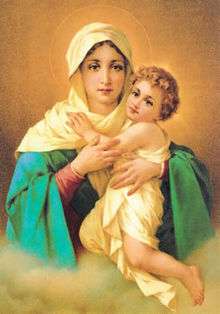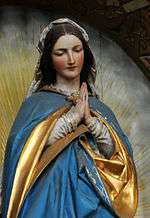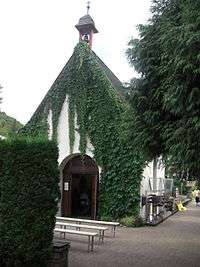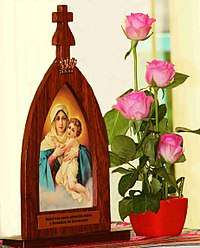Schoenstatt Apostolic Movement
The Apostolic Movement of Schoenstatt (German: Schönstatt-Bewegung) is a Roman Catholic Marian Movement founded in Germany in 1914 by Father Joseph Kentenich, who saw the movement as a means of spiritual renewal for the Catholic Church.[2] The movement is named Schoenstatt (which means "beautiful place") after a small village close to the town of Vallendar near Koblenz in Germany.
| Apostolic Movement of Schoenstatt[1] | |
|---|---|
 | |
| Headquarters | Schoenstatt, Vallendar, Germany |
| Founder | Fr. Joseph Kentenich |
| Origin | 18 October 1914 |
| Recognition | 6 October 1964 |
| Official website | schoenstatt.org |
The group focuses on self-education and spiritual formation. According to its website, "We seek to grow as free, dedicated, and active witnesses of Christ in modern life by uniting our faith with our everyday lives. We look to Mary to educate us in this task and to guide us in becoming better followers of Christ."
History
The Schoenstatt Movement was founded at Schoenstatt, a minor seminary conducted by the Pallottines for those intending to work as missionaries in Africa. It grew out of a Marian sodality established there in April 1914.[3] The superior offered the sodality the use of a derelict chapel devoted to St. Michael, near the school. Father Kentenich, the seminary's spiritual director, inspired in part by the success of Bartolo Longo in establishing the Marian shrine to Our Lady of the Rosary of Pompeii, felt called to establish a new shrine at Schoenstatt.[4]
Kentenich's guidance of the religious brotherhood was influenced by the works of St. Louis Grignion de Montfort.[4]
Schoenstatt officially became a movement with its own structure in 1919. On 18 July 1919, the Pallottines assigned Fr. Kentenich to work full-time with the new movement. The first formal gathering was in Hoerde, 20 August 1920, where the first organizational principles were laid. On 8 December 1920, the first women were accepted into the women's branch of the “Apostolic Federation of Schoenstatt" including Gertraud von Bullion.[3]
Father Kentenich was arrested and sent to the Dachau Concentration Camp in 1941, where he began to spread the message of the Schoenstatt Movement to fellow prisoners.[5]
Mother Thrice Admirable

The picture of Mother Thrice Admirable ("Mater ter Admirabilis" in Latin) was donated by a teacher in 1915. It was painted in 1898 by Luigi Crosio for the Swiss printing house Kunzli Brothers, who produced prints of the image under the title "Refuge of Sinners".[4]
The students renamed the picture "Mother Thrice Admirable", a title used by Father Jakob Rem, SJ, at the Colloquium Marianum in Ingolstadt, in 1604.[6] It has been associated with specific pieces of Roman Catholic Marian art. The spiritual focus of the Marian colloquium of 1604 at Ingolstadt was a copy of the icon of Our Lady Salus Populi Romani, and Father Rem desired to know which of the invocations from the litany of Loreto would please her most. He reported that after meditation, the title Mother Thrice Admirable was revealed to him.
The 1898 Refugium Peccatorum Madonna by the Italian artist Luigi Crosio was purchased by the Schoenstatt Sisters in Switzerland in 1964 and has since been called the Mother Thrice Admirable Madonna, a key symbol of the Schoenstatt movement.[7]
Today
The Schoenstatt Movement consists of a variety of groups:
- The Secular Institutes (such as the Secular Institute of the Schoenstatt Fathers)
- The Apostolic Federation (including the Apostolic Federation of Diocesan Priests)
- The Apostolic Leagues (such as the Apostolic League of Families)
- Youth Branches
- People and Pilgrims[8]
The Schoenstatt Movement is present in approximately 42 countries: Africa (6), Asia (5), Europe (17), North America (5), and South America (9).[2] Groups within the movement include the Pilgrims' Movement, consisting of apostolic leagues without the obligation to live in community; apostolic federations (or unions) with a non-legal obligatory form of community; and secular institutes. Schoenstatt places a great emphasis on the family, and youth are an important part of the movement. There are hundreds of Schoenstatt youth groups throughout the world.
| Part of a series on the |
| Mariology of the Catholic Church |
|---|
 Virgo by Josef Moroder-Lusenberg |
|
|
|
|
|
|
As of April 2020, the Very Reverend Juan Pablo Catoggio is the Superior General of the Secular Institute of Schoenstatt Fathers. On Tuesday, 18 September 2012, Heinrich Walter, a former Superior General, was appointed by Pope Benedict XVI to serve as one of the papally-appointed, non-episcopal, religious-order member Synod Fathers for the October 2012 13th Ordinary General Assembly of the Synod of Bishops on the New Evangelization.[9]
Quotes
According to Father Joseph Kentenich:
[Schoenstatt] wishes to be understood as a universal vision, comprising time and eternity, this world and the next, the economic, social, ethical, political and religious needs of all people, including the dispossessed, the millions of masses. …It wants to help redeem the world not only from its earthly sufferings, but also from sin and from its alienation from God. It tries to do this under the guidance and in the school of Our Lady by applying the original principles of Christianity in a new way to restore the disturbed relationship between the individual person and society, the person and business, the person and technology, and the person and social advancement.
Focus

Central issues are the ideas based on that which Joseph Kentenich founded the movement in 1914, including Christian personality development, orientation toward ideals, and community.
A central point in the movement dynamics and faith is the devotion to the Schoenstatt Shrine, based on the first shrine in Schoenstatt where the movement started, with a special devotion to Mary, for whom there are over 200 replicas around the world.
Apostolic actions
The movement is involved in several apostolic actions, including missionary work, charity, education, and other projects. The most widespread activity is the Pilgrim Mother Campaign, now spanning more than 110 countries in the world, with around 30 million members.[10]
Youth Festival
In the summer of 2005 about four thousand young people from all around the world – Germany, Poland, England, Italy, Uruguay, Argentine, Chile, Mexico, Puerto Rico, Costa Rica, Africa, United States, etc. – gathered for almost a week around the Original Shrine in Schönstatt, Vallendar, for the Schönstatt Youth Festival prior to the WJT (World Youth Day) in Cologne. This event ignited the youth around the world, bringing renewal and energy to continue in the mission set by the Blessed Mother to each and every one there.
Schoenstatt Summer
After the success of the Youth Festival the prior year, it became obvious that there should be something to bring together each year the youth of the world, around the Original Shrine. During the Summer of 2006 Volunteers from Germany, Mexico, United States, Poland, Puerto Rico, Chile, Argentina, Portugal, and Kenya, worked together to create a month-long program for young pilgrims from all over the world. This was the first of many Schoenstatt Summers. The Night of the Shrine was the conclusion of this month-long program. At midnight on 27 August, over 400 people gathered for Holy Mass around the Original Shrine. Together with them, the youth of the world in more than 90 Shrines, spread around the 5 continents, celebrated this Mass at the same moment. Each Shrine celebrated in their own special way according to the traditions of their country this World Youth Mass.
Notable members
- Joseph Kentenich (1885–1968), founder of the Schoenstatt Movement
- Blessed Karl Leisner (1915–1945), priest and martyr
- Venerable Mario Hiriart (1931–1964)
- Servant of God John Pozzobon (1904-1985), founder of the Schoenstatt Rosary Campaign
- Emilie Engel (1893–1955)
- Josef Engling (1898–1918)
- Francisco Javier Errázuriz Ossa, Cardinal Archbishop Emeritus of Santiago, Chile
- Jose Antonio Kast, lawyer and politician
- Franz Reinisch (1903–1942)
References
- "Apostolic Movement of Schoenstatt". Pontifical Council for the Laity. Retrieved 27 May 2017.
- "International Associations of the Faithful, Directory - Pontifical Coucils for the Laity". www.vatican.va. Retrieved 8 February 2020.
- Niehaus, Jonathan (2005). 200 Questions about Schoenstatt (3 ed.). Schoenstatt Fathers.
- Niehaus, Jonathan. "Aspects of Schoenstatt's Marian Spirituality
- "Historical Panorama of Schoenstatt: From the Little Chapel to the Confines of the Earth", Schoenstatt Apostolic Movement Archived 5 December 2012 at the Wayback Machine
- "Thrice Admirable: Why? : University of Dayton, Ohio". udayton.edu. Retrieved 8 February 2020.
- Schoenstatt website "Archived copy". Archived from the original on 10 October 2009. Retrieved 18 July 2008.CS1 maint: archived copy as title (link)
- Crivelli, Monica."A Federal Movement", Schoenstatt Apostolic Movement Archived 2 December 2012 at the Wayback Machine
- "Rinunce e Nomine, 18.09.2012" (Press release) (in Italian). Holy See Press Office. 18 September 2012. Retrieved 26 January 2018.
- "Projekt Pilgerheiligtum | Schönstattbewegung Schweiz". schoenstatt.ch. Retrieved 1 June 2016.
Sources and external links
- Schoenstatt Movement around the World
- Schoenstatt Movement Europe
- Schoenstatt Movement Germany
- Schoenstatt Movement Belgium
- Schoenstatt Movement England
- Schoenstatt Movement Scotland
- Schoenstatt Movement Australia
- Schoenstatt Movement Chile
- Schoenstatt Movement Paraguay
- Schoenstatt Movement Brazil
- GCatholic
- Wiki dedicated to Schoenstatt in Spanish (the most) for the moment
- Schoenstatt Life (Spanish)

